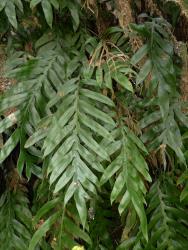Terrestrial, rupestral or climbing ferns (NZ) or rarely epiphytic or aquatic (not NZ). Rhizomes erect or short- to long-creeping, scaly. Fronds monomorphic or dimorphic, not articulated to rhizome. Laminae entire to 1-pinnate, or rarely up to 2-pinnate, catadromous, herbaceous or coriaceous or rarely slightly fleshy, scaly and sometimes hairy or rarely glabrous. Veins free or anastomosing. Sori elongate to continuous on a vein parallel to the mid-vein or costa (NZ), or rarely acrostichoid (not NZ); receptacles raised or flat; paraphyses absent; indusia present (NZ) or rarely absent (not NZ), attached to the receptacle and opening towards the costae; sporangial maturation mixed. Sporangia with vertical annulus, usually 64 spores per sporangium. Homosporous; spores monolete, lacking chlorophyll; perispores very variable, smooth, papillate, echinate, tuberculate, cristate or verrucate.
As interpreted here, a family of seven genera (Perrie et al. 2014) and about 265 species (PPG 1 2016), but as many as 24 genera are recognised by Gasper et al. (2016), with one of those split into two by Molino et al. (2019).
Recent treatments of Blechnaceae have generally recognised eight to ten genera (Kramer et al. 1990; Chambers & Farrant 1998, 2001, 2012; Smith et al. 2006; Rothfels et al. 2012), variously including Blechnum, Brainea, Diploblechnum, Doodia, Pteridoblechnum, Sadleria, Salpichlaena, Steenisioblechnum, Stenochlaena and Woodwardia. Over 200 species belong to Blechnum and about 50 are distributed amongst the other genera. However, several phylogenetic analyses have indicated that these are not monophyletic groupings (Cranfill 2001; Shepherd et al. 2007; Perrie et al. 2014; Gasper et al. 2017).
Using chloroplast DNA sequences from all genera and 113 species of Blechnaceae, Perrie et al. (2014) showed that Blechnum indicum and B. serrulatum were more closely related to Salpichlaena and Stenochlaena, and segregated them as the new genus Telmatoblechnum. However, they also showed that Doodia, Diploblechnum, Pteridoblechnum and Steenisioblechnum were all nested within Blechnum. In the absence of convincing morphological characters to diagnose clades within Blechnum, and in the interests of taxonomic stability, their interpretation of the phylogeny was a conservative one, retaining Brainea, Sadleria, Salpichlaena, Stenochlaena and Woodwardia alongside the new Telmatoblechnum and a broadly circumscribed, but monophyletic, Blechnum. Of these, only Blechnum occurs in New Zealand.
Gasper et al. (2017) extended sampling to about 150 species, especially from the Neotropics and Africa/Madagascar. Their phylogenetic results were essentially the same, but their interpretation of the phylogeny was radically different, recognising 24 genera, 11 of them with five species or less, and seven monotypic (Gasper et al. 2016). In this scheme, seven genera are indigenous to New Zealand – Austroblechnum, Cranfillia, Diploblechnum, Doodia, Icarus, Lomaria and Parablechnum – and two include introduced species – Austroblechnum and Blechnum sens. str.
In our opinion, the classifications of Gasper et al. (2016, 2017) and Molino et al. (2019) split the group excessively, with too many tiny genera. The total of 25 genera for a family of 265 species seems discordant compared to similar-sized fern families that have one to ten genera (PPG 1 2016). In addition, whilst some of their genera are morphologically well supported, others are not, as is evidenced by the fact that eight of the genera are retrieved in multiple places in their key (Gasper et al. 2016). This makes recognition of genera difficult in the field, laboratory and classroom. There is also evidence of hybridisation between species in different genera. Doodia and Oceaniopteris often hybridise where they co-occur in Australia (Parris 1998; Field 2020; Hong-Mei et al. 2020), and although they are at the heart of the segregated system proposed by Gasper et al. (2017), there is no strong genetic support for their reciprocal monophyly. Like that of Gasper et al. (2017), the classification advocated by Perrie et al. (2014) provides a monophyletic system, but with far fewer name changes and less taxonomic disruption, and is therefore better for the general user of taxonomic names.
The family Blechnaceae comprises mostly terrestrial ferns, often with strongly dimorphic fronds, sori that are elongate or continuous parallel to the costae, and indusia that open towards the costae.
A family found throughout the world but with the majority of species in the southern hemisphere. There are two main centres of diversity and endemism in Central and South America, and in Australasia and the south-west Pacific, with a smaller one in the Malesian region. One non-endemic genus with 25 species in New Zealand; 13 endemic, ten indigenous and two casual.
| Category | Number |
|---|---|
| Indigenous (Endemic) | 15 |
| Indigenous (Non-endemic) | 10 |
| Exotic: Casual | 2 |
| Total | 27 |




